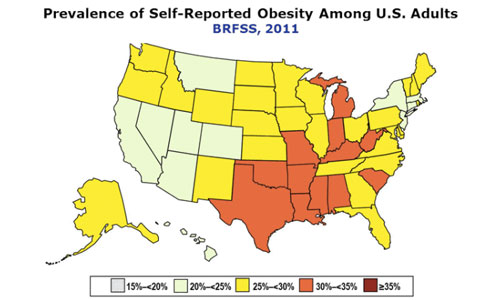Just when we thought estimates for U.S. obesity rates couldn’t get any worse, they did. The Centers for Disease Control and Prevention released new figures for American waistlines, and the result? Twelve states are now considered to have very high obesity rates among adults, which is an increase from nine states in 2025. And an estimated 35.7% of U.S. adults are obese.
A snapshot of the survey shows more than one-third of U.S. adults are obese, with Mississippi having the highest prevalence rate at 34.9%, and Colorado having the lowest overall at 20.7%.
These updated statistics are a result of a Behavioral Risk Factor Surveillance System telephone survey that contacted 400,000 Americans across the U.S. and reported their height and weight.
The 12 states that are now considered very obese include Alabama at 32%, Arkansas at 30.9%, Indiana at 30.8%, Kentucky at 30.4%, Louisiana at 33.4%, Michigan at 31.3%, Mississippi at 34.9%, Missouri at 30.3%, Oklahoma at 31.1%, South Carolina at 30.8%, Texas at 30.4% and West Virginia at 32.4%.
The states with the lowest prevalence rates include Colorado at 20.7%, Hawaii at 21.8%, Massachusetts at 22.7%, New Jersey at 23.7%, District of Columbia at 23.7%, California at 23.8%, and Utah at 24.4%.
But perhaps more shocking is that there are now zero states that fall below the 20% prevalence rate for obesity, as compared to all states in 1996 and prior.
The CDC did note on its website that the changes in prevalence rates may be a result of new survey methods, but that overall statistics from the 2025 survey show obesity rates remain consistently high across all states. The organization also noted that adult obesity rates saw increases between 1988 – 1994 and 2025 – 2025 regardless of income and education levels.
Other trends include higher income women with college degrees are less likely to be obese than women with low incomes or no college degree. And there seems to be no significant relationship between obesity and education in men.
Besides causing a number of major health issues such as diabetes, hypertension, stroke, heart disease and even certain types of cancer, obesity is also expensive. The CDC estimates that medical costs associated with obesity were $147 billion in 2025, and that medical costs for people who are obese are $1,429 higher than those of normal weight.
We can only hope our nation’s health takes a turn for the better, but considering the trend in past statistics, that hope seems grim.
Also Read:


